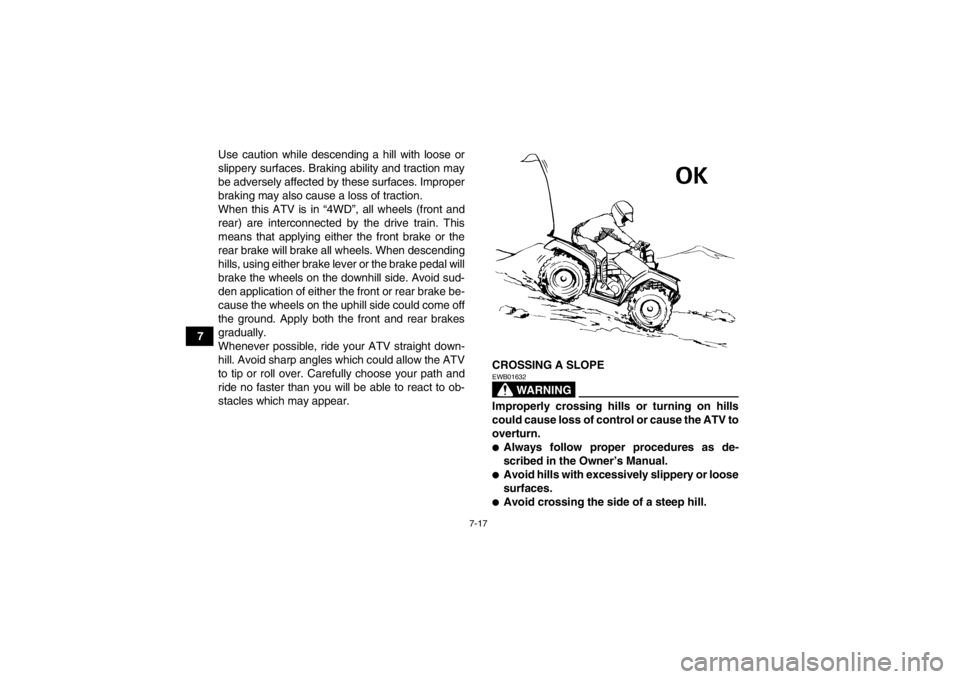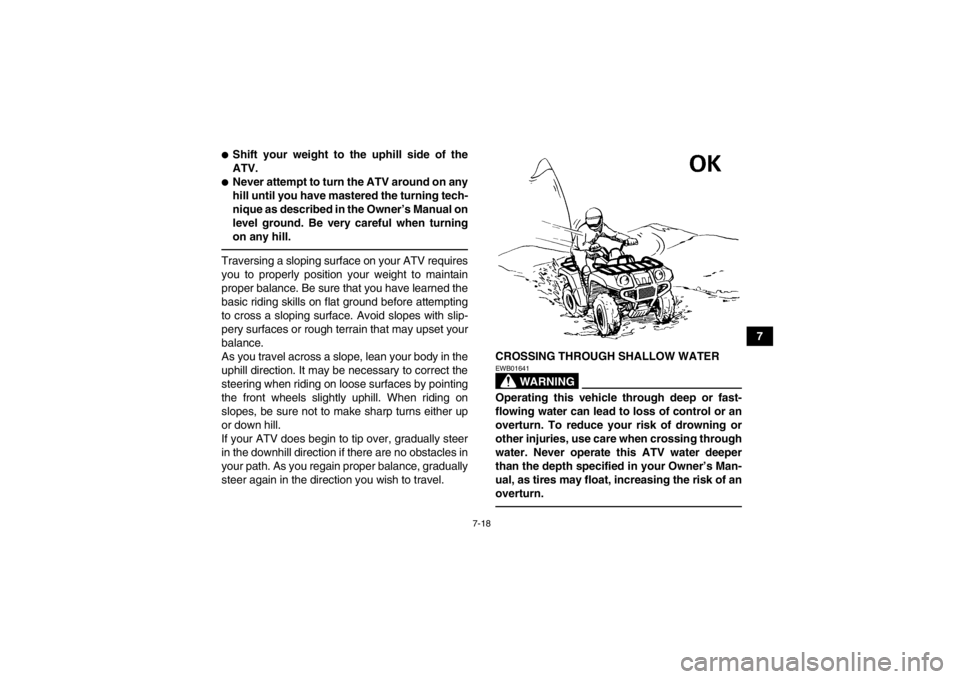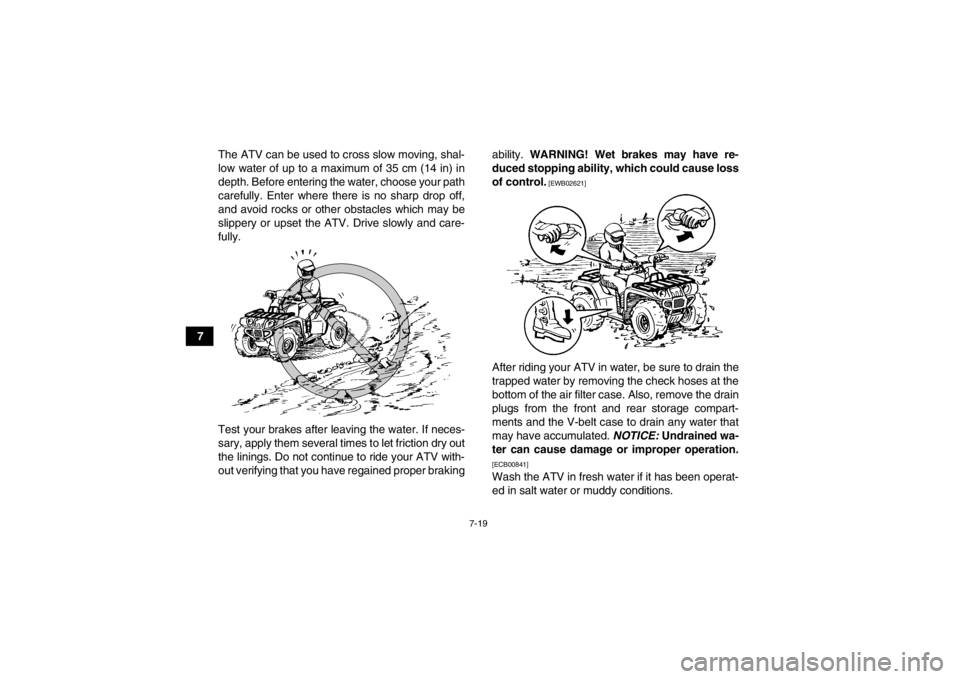Page 86 of 174

7-17
7Use caution while descending a hill with loose or
slippery surfaces. Braking ability and traction may
be adversely affected by these surfaces. Improper
braking may also cause a loss of traction.
When this ATV is in “4WD”, all wheels (front and
rear) are interconnected by the drive train. This
means that applying either the front brake or the
rear brake will brake all wheels. When descending
hills, using either brake lever or the brake pedal will
brake the wheels on the downhill side. Avoid sud-
den application of either the front or rear brake be-
cause the wheels on the uphill side could come off
the ground. Apply both the front and rear brakes
gradually.
Whenever possible, ride your ATV straight down-
hill. Avoid sharp angles which could allow the ATV
to tip or roll over. Carefully choose your path and
ride no faster than you will be able to react to ob-
stacles which may appear.
CROSSING A SLOPE
WARNING
EWB01632Improperly crossing hills or turning on hills
could cause loss of control or cause the ATV to
overturn.●Always follow proper procedures as de-
scribed in the Owner’s Manual.●Avoid hills with excessively slippery or loose
surfaces.●Avoid crossing the side of a steep hill.
U1HS61E0.book Page 17 Wednesday, May 23, 2012 5:24 PM
Page 87 of 174

7-18
7
●Shift your weight to the uphill side of the
ATV.●Never attempt to turn the ATV around on any
hill until you have mastered the turning tech-
nique as described in the Owner’s Manual on
level ground. Be very careful when turning
on any hill.Traversing a sloping surface on your ATV requires
you to properly position your weight to maintain
proper balance. Be sure that you have learned the
basic riding skills on flat ground before attempting
to cross a sloping surface. Avoid slopes with slip-
pery surfaces or rough terrain that may upset your
balance.
As you travel across a slope, lean your body in the
uphill direction. It may be necessary to correct the
steering when riding on loose surfaces by pointing
the front wheels slightly uphill. When riding on
slopes, be sure not to make sharp turns either up
or down hill.
If your ATV does begin to tip over, gradually steer
in the downhill direction if there are no obstacles in
your path. As you regain proper balance, gradually
steer again in the direction you wish to travel.CROSSING THROUGH SHALLOW WATER
WARNING
EWB01641Operating this vehicle through deep or fast-
flowing water can lead to loss of control or an
overturn. To reduce your risk of drowning or
other injuries, use care when crossing through
water. Never operate this ATV water deeper
than the depth specified in your Owner’s Man-
ual, as tires may float, increasing the risk of an
overturn.
U1HS61E0.book Page 18 Wednesday, May 23, 2012 5:24 PM
Page 88 of 174

7-19
7The ATV can be used to cross slow moving, shal-
low water of up to a maximum of 35 cm (14 in) in
depth. Before entering the water, choose your path
carefully. Enter where there is no sharp drop off,
and avoid rocks or other obstacles which may be
slippery or upset the ATV. Drive slowly and care-
fully.
Test your brakes after leaving the water. If neces-
sary, apply them several times to let friction dry out
the linings. Do not continue to ride your ATV with-
out verifying that you have regained proper braking ability.
WARNING! Wet brakes may have re-
duced stopping ability, which could cause loss
of control.
[EWB02621]
After riding your ATV in water, be sure to drain the
trapped water by removing the check hoses at the
bottom of the air filter case. Also, remove the drain
plugs from the front and rear storage compart-
ments and the V-belt case to drain any water that
may have accumulated. NOTICE: Undrained wa-
ter can cause damage or improper operation.[ECB00841]Wash the ATV in fresh water if it has been operat-
ed in salt water or muddy conditions.
U1HS61E0.book Page 19 Wednesday, May 23, 2012 5:24 PM
Page 90 of 174

7-21
7RIDING OVER ROUGH TERRAIN
WARNING
EWB01651Riding improperly over obstacles could cause
loss of control or a collision. Before operating
in a new area, check for obstacles. Never at-
tempt to ride over large obstacles, such as
large rocks or fallen trees. When you go over
obstacles, always follow proper procedures as
described in the Owner’s Manual.Riding over rough terrain should be done with cau-
tion. Look out for obstacles which could cause
damage to the ATV or could lead to an upset or ac- cident. Be sure to keep your feet firmly mounted on
the footboards at all times. Avoid jumping the ATV
as loss of control and damage to the ATV may re-
sult.
SLIDING AND SKIDDING
WARNING
EWB01662Skidding or sliding improperly may cause you
to lose control of this ATV. You may also re-
gain traction unexpectedly, which may cause
the ATV to overturn.●Learn to safely control skidding or sliding by
practicing at low speeds and on level,
smooth terrain.●On extremely slippery surfaces, such as ice,
go slowly and be very cautious in order to re-
duce the chance of skidding or sliding out of
control.Care should be used when riding on loose or slip-
pery surfaces since the ATV may slide. If unex-
pected and uncorrected, sliding could lead to an
accident.
To reduce the tendency for the front wheels to slide
in loose or slippery conditions, positioning your
weight over the front wheels will sometimes help.
1. V-belt case drain plugU1HS61E0.book Page 21 Wednesday, May 23, 2012 5:24 PM
Page 93 of 174

8-1
8
EBU28783
PERIODIC MAINTENANCE AND ADJUSTMENT
EBU21674Periodic inspection, adjustment, and lubrication
will keep your vehicle in the safest and most effi-
cient condition possible. Safety is an obligation of
the vehicle owner/operator. The most important
points of vehicle inspection, adjustment, and lubri-
cation are explained on the following pages.
WARNING
EWB01841Failure to properly maintain the vehicle or per-
forming maintenance activities incorrectly may
increase your risk of injury or death during ser-
vice or while using the vehicle. If you are not fa-
miliar with vehicle service, have a Yamaha
dealer perform the service.
WARNING
EWB02562Turn off the engine when performing mainte-
nance unless otherwise specified.●A running engine has moving parts that can
catch on body parts or clothing and electri-
cal parts that can cause shocks or fires.
●Running the engine while servicing can lead
to eye injury, burns, fire, or carbon monoxide
poisoning - possibly leading to death. See
page 2-6 for more information about carbon
monoxide.
WARNING
EWB02690Brake discs, calipers, drums, and linings can
become very hot during use. To avoid possible
burns, let brake components cool before
touching them.The intervals given in the periodic maintenance
charts should be considered as a general guide
under normal riding conditions. However, DE-
PENDING ON THE WEATHER, TERRAIN, GEO-
GRAPHICAL LOCATION, AND INDIVIDUAL
USE, THE MAINTENANCE INTERVALS MAY
NEED TO BE SHORTENED.
U1HS61E0.book Page 1 Wednesday, May 23, 2012 5:24 PM
Page 125 of 174

8-33
8
protected against frost and corrosion. If
water has been added to the coolant, have
a Yamaha dealer check the antifreeze con-
tent of the coolant as soon as possible,
otherwise the effectiveness of the coolant
will be reduced.
[ECB01011]
TIP●The radiator fan is automatically switched on or
off according to the coolant temperature in the
radiator.●If the engine overheats, see page 8-68 for fur-
ther instructions.EBU27767To change the coolant
WARNING
EWB01890Wait for the engine and radiator to cool before
removing the radiator cap. You could be
burned by hot fluid and steam blown out under
pressure. Always place a thick rag over the cap
when opening. Allow any remaining pressure
to escape before completely removing the cap.1. Place the ATV on a level surface.
2. Remove panel D. (See page 8-10.)
3. Remove the footboard by removing the bolts
and nuts.
1. Coolant reservoir cap
2. Maximum level mark
3. Minimum level markCoolant reservoir capacity (up to the maxi-
mum level mark):0.24 L (0.25 US qt, 0.21 Imp.qt)
U1HS61E0.book Page 33 Wednesday, May 23, 2012 5:24 PM
Page 133 of 174
8-41
8
5. Clean the mesh with solvent, and then wipe the solvent off. 6. Wash the sponge material gently, but thor-
oughly, in solvent. WARNING! Always use
parts cleaning solvent to clean the sponge
material. Never use low-flash-point sol-
vents or gasoline to clean the sponge ma-
terial because the engine could catch fire
or explode.
[EWB01941]
7. Squeeze the excess solvent out of the sponge material and let it dry. NOTICE: Do not twist
the sponge material when squeezing it.
[ECB00441]
8. Check the sponge material and replace it if damaged.
9. Apply Yamaha foam air filter oil or other qual- ity foam air filter oil to the sponge material.
1. Sponge material
2. Air filter meshU1HS61E0.book Page 41 Wednesday, May 23, 2012 5:24 PM
Page 137 of 174

8-45
8
WARNING
EWB02380Never run the engine in an enclosed area when
purging the spark arrester, otherwise it could
cause injury to the eyes, burns, carbon monox-
ide poisoning, possibly leading to death, and
start a fire.●Always let the exhaust system cool prior to
touching exhaust components.●Always wear eye protection, and make sure
no one is behind the ATV.●Make sure there are no combustible materi-
als in the area.EBU23931V-belt case drain plug After riding in water deep enough to allow it to en-
ter the V-belt case, remove the V-belt case drain
plug to drain the water from the case.
TIPIf water drains from the V-belt case after removing
the plug, have a Yamaha dealer check the ATV as
the water may affect other engine parts.EBU29702Adjusting the throttle lever free play The throttle lever free play should be checked and,
if necessary, adjusted at the intervals specified in
the periodic maintenance and lubrication chart.
The throttle lever free play should measure 3.0–
5.0 mm (0.12–0.20 in) as shown. Periodically
check the throttle lever free play and, if necessary,
adjust it as follows.
Tightening torque:
Purging bolt:27 Nm (2.7 m·kgf, 20 ft·lbf)1. V-belt case drain plug
U1HS61E0.book Page 45 Wednesday, May 23, 2012 5:24 PM